Contents
Rosehip is a culture that can decorate any garden plot, as well as benefit human health. The fruits, leaves and flowers of the plant are of value, as they contain a large amount of vitamins and a complex of minerals. This shrub belongs to the category of unpretentious crops, so it does not cause much trouble to the gardener. However, if the growing conditions do not match, its immunity weakens. Therefore, you should study the common diseases of the wild rose and its pests, as well as familiarize yourself with how to deal with them.
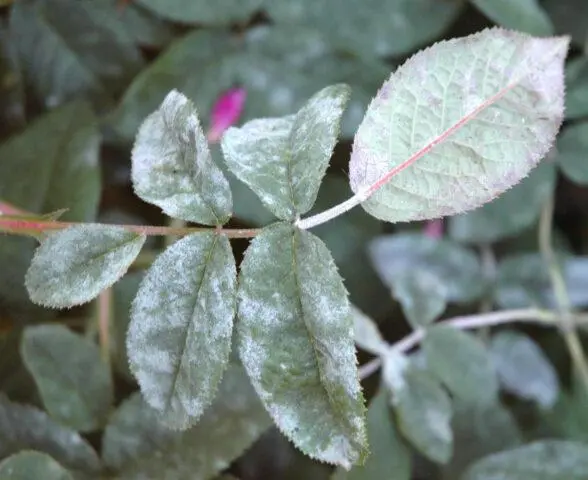
Most often, rose hips are affected by fungal diseases.
Causes of diseases and pests
This crop is a wild form of garden roses. Therefore, she is more enduring and unpretentious. However, for the full growth and development of the shrub, certain conditions are necessary. If they do not match, the plant weakens.
Main reasons:
- sharp temperature drops;
- prolonged stagnation of moisture in the soil;
- dry air;
- lack of nutrients;
- density of landings;
- bad light;
- unsuitable climate.
Rosehip diseases and their treatment
Most of the diseases of this shrub are successfully treated. However, so that the defeat does not cause serious damage to the plant, it is necessary to take measures at the initial stage of their development. Therefore, you need to study the photo and description of the main rosehip diseases and methods for their treatment. This will allow you to easily identify the problem and fix it in a timely manner.
Mučnistaâ rosa
Powdery mildew is caused by various fungi from the order Erysiphales. Causing factors: high humidity and high temperature. The disease can be recognized by white spots on the leaves, which subsequently increase in size and completely cover the plates. This hinders the process of photosynthesis.
Over time, the plaque becomes denser and acquires a dirty gray hue, as the hibernating stages of the pathogen fungus appear in it. As a result, the affected leaves gradually wither and fall off. If left untreated, shrub shoots may remain completely bare. Subsequently, the disease spreads to young shoots and buds of the plant.
To treat the powdery mildew disease in rose hips, it is necessary to spray the crown with Topaz, Tiovit and Skor.
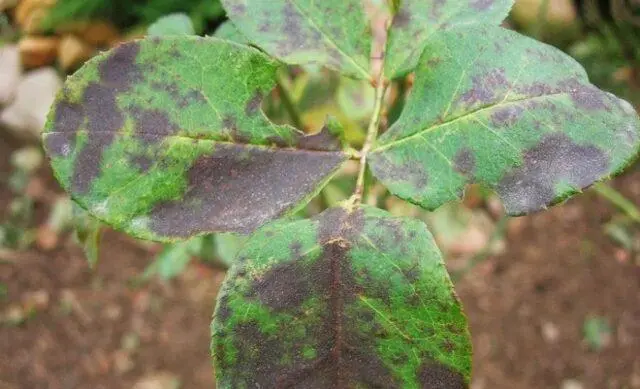
Powdery mildew leads to disruption of metabolic processes in tissues
Rust
The causative agent is the fungus Phragmidium disciflorum (Tode) James. Rust is a rosehip disease that affects the stems, young shoots and leaves of the plant. Warm weather and high humidity in spring contribute to its spread.
The affected shoots of the shrub due to the disease thicken and crack significantly. A bright red dusty powder emerges from open wounds.
On rosehip leaves, rust appears as rounded spots. On the reverse side of the plates, orange-colored pustules grow in their place, powdering with spores. Pathogens are stored in plant debris and cracks in the bark, where they hibernate. Rust disease is more common in yellow rose hips.
If signs of this disease are found on the wild rose, all affected areas must be removed and burned. After that, you need to spray the bush with a 3% solution of copper sulfate, and after a week, repeat the treatment, but already with 1% Bordeaux mixture.
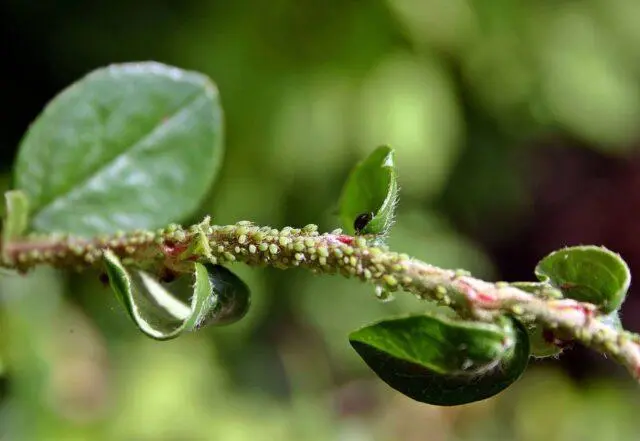
Cracks in the bark with rust subsequently turn into superficial brown ulcers
Black spot
Black spot is caused by the fungus Marssonina rosae. The disease affects leaves, but sometimes young growing shoots. It can be identified on the wild rose by rounded spots of brown, almost black, color. Initially, they are small, solitary, with a diameter of 5-15 mm. In the future, black crusts appear on necrotic areas – spores of the fungus.
Affected leaves gradually turn brown and fall off. As a result, by the fall, completely bare shoots of wild rose remain. The pathogen persists in winter in plant debris and in cracks in the bark.
For the treatment of black spot, it is recommended to pre-clean the wild rose bush from the affected leaves and shoots, and then spray it twice with Hom with a frequency of 7 days.
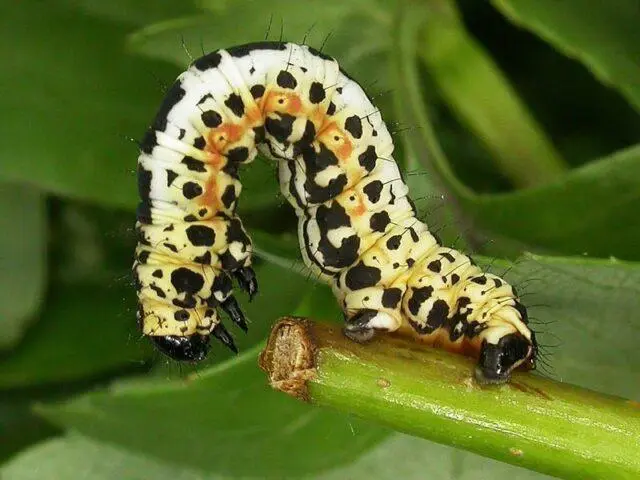
Young stems do not ripen due to black spot disease
Septoria spotting
The disease is manifested by numerous rounded spots on the leaves, which are randomly scattered. The causative agent of Septoria blotch is the fungus Septoria rosae Desm. As the disease progresses, a bright spot appears in the center of the necrotic areas. But along the edge, a thin brown rim is preserved.
Over time, small black fruiting bodies form in this place, inside which spores ripen. Affected plates wither, which leads to premature leaf fall. In the presence of favorable conditions, the disease passes to the hips and young shoots. This causes the death of areas of the cortex. In the future, such stems dry out.
To treat wild rose, it is necessary to clean the crown from possible sources of the pathogen. All collected leaves and shoots are to be burned. After that, spray with a 1% solution of Bordeaux mixture. If necessary, repeat the treatment after a week.
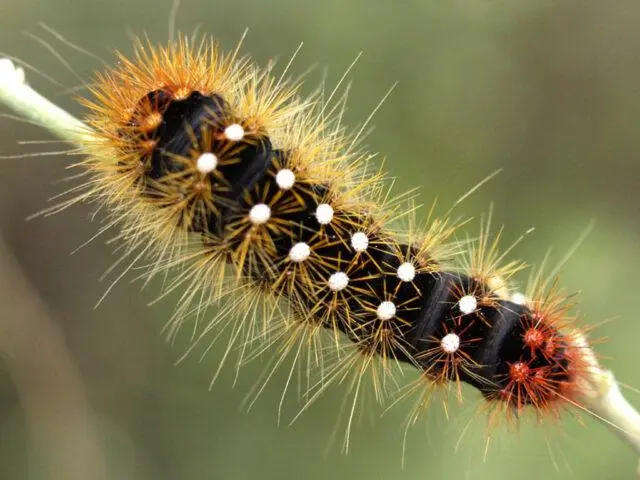
Septoria blotch persists in winter in plant debris
Rosehip pests and their control
Not only diseases cause damage to the wild rose, but also pests. They weaken the bush, which leads to its freezing in winter. Also, many insects are carriers of infections, which aggravates the problem and can cause the death of the plant.
aphid
This small insect feeds on the juice of young leaves and shoots. Aphids (Aphidoidea) are able to form entire colonies. Initially, you can detect the pest from the back of the plates. As a result of their vital activity, the leaves are deformed, the buds do not open, and the fruits become smaller.
To combat the pest, it is necessary to spray the plant with Inta-Vir, Decis or Confidor Extra.
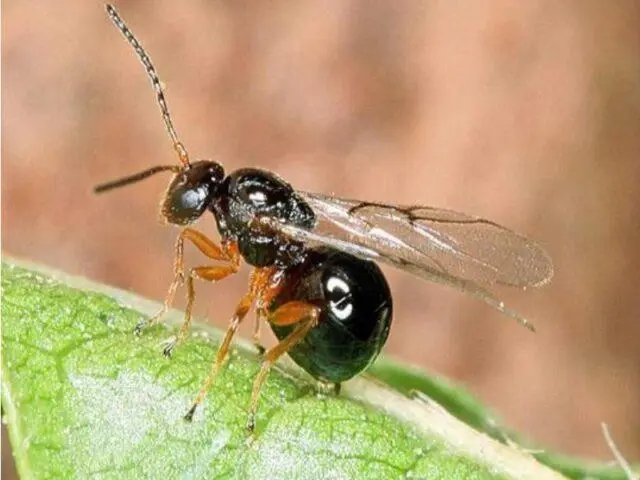
With mass distribution, numerous individuals of aphids stick around the tops of the stems.
Leaflet
This pest parasitizes mainly on fruit trees in the garden, but in case of mass distribution it can switch to wild rose. A characteristic sign of the lesion is the wrapped rosehip leaves inside. The adult leafworm is a yellow butterfly with brown patterns on the body. In length, it reaches 15-20 mm.
The leaf roller (Tortricidae) lays eggs that overwinter on the plant. And with the advent of spring warmth, voracious caterpillars appear from them. It is they who harm the wild rose, as they eat its flowers, buds and pistils.
To destroy the leaflet, it is necessary to spray the shrub in the spring at a temperature of +8 degrees and above with Confidor Maxi, Liber and Cesar.

Peak leafworm breeding occurs in July
Pheidenitsa
This lepidoptera also infects wild rose. Moth (Anticlea derivata) has a delicate body and wide wings, the span of which reaches 3 cm. The color of the insect is spectacular. The main color is white, but it has black dots and yellow stripes. Moth caterpillars are the same color as adults. They eat rosehip leaves as well as buds.
To destroy the moth, Zolon, Karbofos, Kinmiks and Decis should be used.
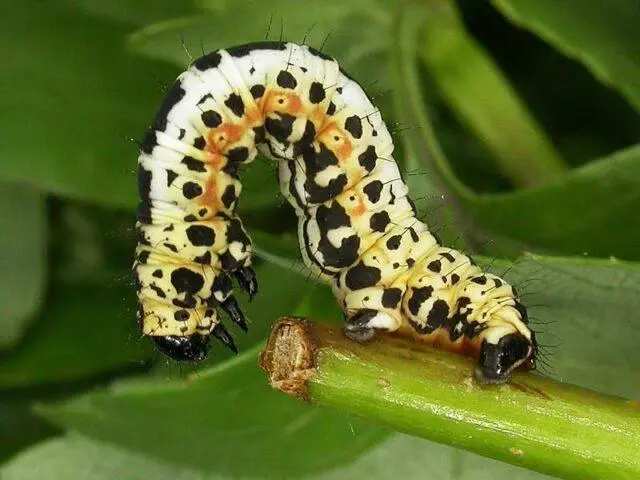
The moth can eat all the leaves on the wild rose if you don’t fight it.
Sawfly
There are many types of this pest. All of them resemble a fly in body structure and have membranous wings. Most often, the wild rose affects the rose sawfly (Arge ochropus). Its larvae are green in color, the head is red-brown in color with a light spot on the back of the head. The insect has 8 pairs of limbs. It feeds on rosehip leaves, eating them around the edges, and forming holes.
For destruction, it is necessary to spray the plant with insecticides: Kemifos, Fufanon, Inta-vir.
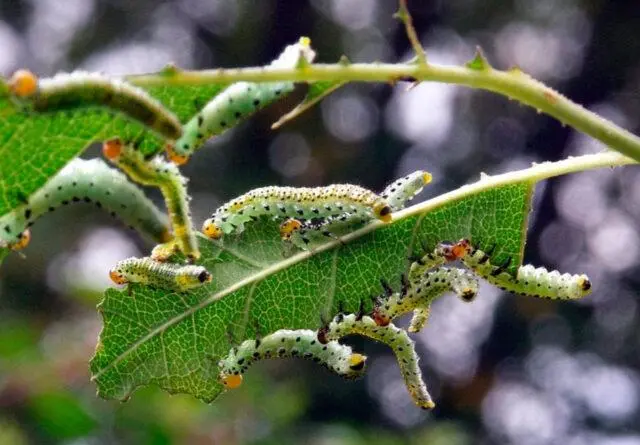
Sawfly larvae appear on wild roses at the end of June
small shooter
This pest is a butterfly. The length of its wedge-like body reaches 25 mm. The abdomen is narrowed towards the end of the body. The color of the small shooter (Acronictinae) is brown-gray. The thoracic part of the butterfly is covered with long dense villi. The caterpillars are dangerous for wild rose. They reach a length of 30-40 mm. The body of the larvae is gray-brown with a longitudinal yellow-red stripe, which is interrupted by black transverse lines. The first generation of arrowhead offspring appears in June, and the second at the end of summer or at the beginning of autumn. Caterpillars eat rosehip leaves.
To combat the arrowhead, Aktofit should be used at the rate of 8 ml per bucket of water. The resulting solution should be sprayed on the crown of the plant in an even layer.
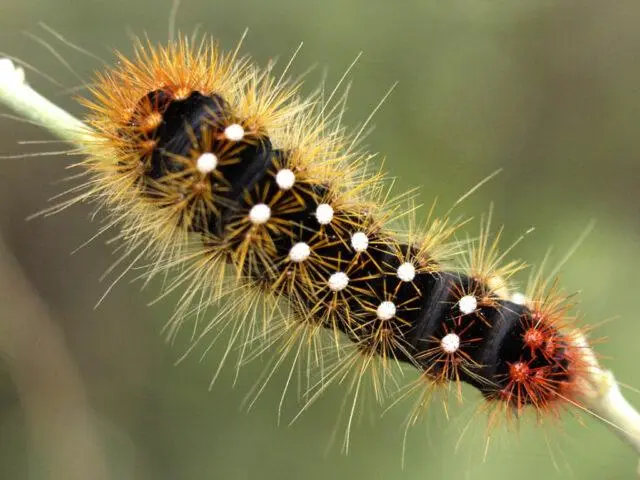
In addition to the wild rose, the small shooter eats an apple tree, raspberry, hawthorn and plum
Olenka shaggy
This black beetle is also capable of dealing damage to briar. Its length varies within 8-12 mm. The body is broadly oval, completely covered with dense gray hairs. The summer period of the hairy deer (Epicometis hirta Poda) lasts from May to August. The beetle eats away the petals, stamens and pistils of wild rose flowers. Females lay their eggs in the soil, later white curved larvae with a brown head and three pairs of limbs emerge from them.
When beetles appear on the wild rose, they must be collected manually, and the larvae should be destroyed while digging the site.
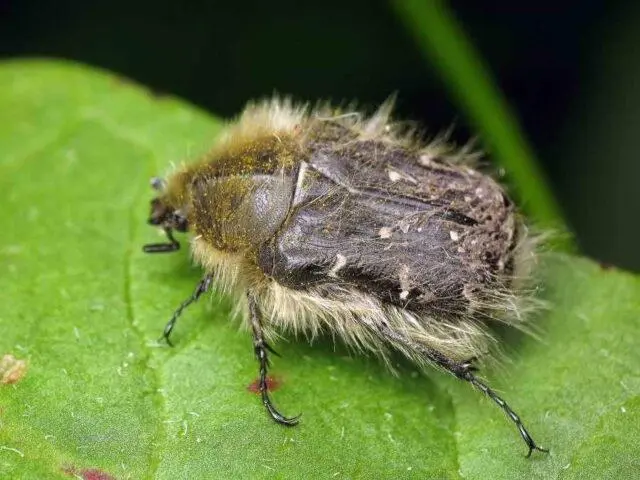
The hairy deer prefers soil rich in vermicompost, where it reproduces offspring
Wavy hazelnut
This membranous-winged insect also poses a threat to the wild rose. The pest causes the formation of single- and multi-chamber galls on fruits, the length of which is 10-12 mm. Their shell grows and increases to a diameter of 22 mm, and then covered with spikes and bursts.
As a result of the vital activity of the wavy nutworm (Rhodites fluctum Rubs), rosehip seeds become spindle-shaped. Over time, the gall acquires a brown color and dries up. For the prevention and destruction of the pest, it is recommended to spray the shrub before and after flowering with Decis, Karate and Kinmiks.
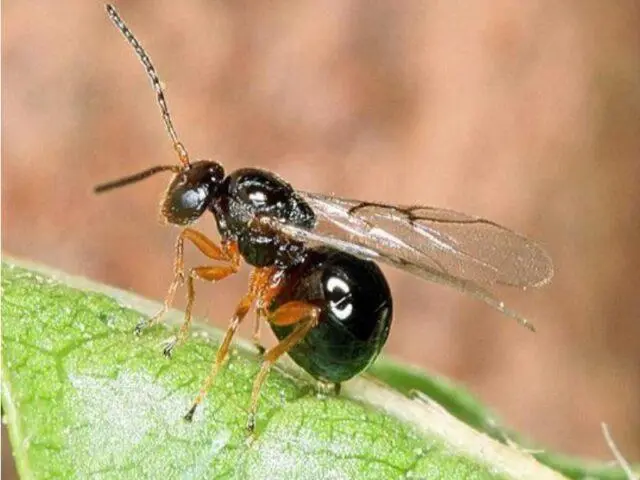
The nutcracker lays eggs in autumn, and in the spring, offspring appear from them.
Prevention
You can minimize the likelihood of developing diseases on the wild rose if you follow the simple rules of prevention. They also help to increase the immunity of the plant, which will allow it to withstand the attack of pests.
Preventive measures:
- timely removal of weeds in the root circle;
- fertilizing taking into account the stages of shrub development;
- removal of plant residues in the fall;
- burning fallen leaves;
- loosening the soil at the base of the shrub;
- cleaning the crown from broken and damaged shoots;
- treatment in spring and autumn of plants from diseases with a Bordeaux mixture.
Conclusion
Rosehip pests and diseases can significantly weaken the shrub. This will lead to the fact that he will not be able to fully develop, bloom and bear fruit. Therefore, to prevent this from happening, it is necessary to regularly inspect the plant and take action if signs of damage appear.









